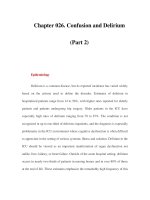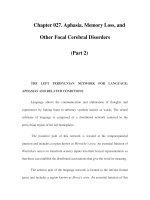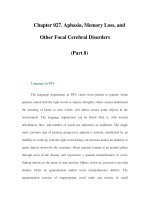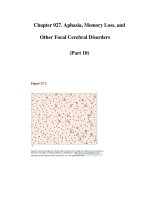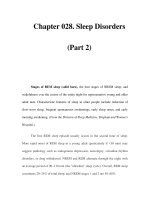Chapter 110. Coagulation Disorders (Part 2) potx
Bạn đang xem bản rút gọn của tài liệu. Xem và tải ngay bản đầy đủ của tài liệu tại đây (37.29 KB, 5 trang )
Chapter 110. Coagulation Disorders
(Part 2)
Commonly used tests of hemostasis provide the initial screening for
clotting factor activity (Fig. 110-1), and disease phenotype often correlates with
the level of clotting activity. An isolated abnormal prothrombin time (PT) suggests
FVII deficiency, whereas a prolonged activated partial thromboplastin time
(aPTT) indicates most commonly hemophilia or FXI deficiency (Fig. 110-1).
The prolongation of both PT and aPTT suggests deficiency of FV, FX, FII,
or fibrinogen abnormalities. The addition of the missing factor to the subject's
plasma at a range of doses will correct the abnormal clotting times; the result is
expressed as percent of the activity observed in normal subjects.
Figure 110-1
Coagulation cascade and laboratory assessment of clotting factor
deficiency
by activated partial prothrombin time (aPTT), prothrombin time (PT),
and thrombin time (TT).
Acquired deficiencies of plasma coagulation are more frequent than
congenital disorders; the most common disorders include hemorrhagic diathesis of
liver disease, disseminated intravascular coagulation (DIC), and vitamin K
deficiency. In these disorders, blood coagulation is hampered by the deficiency of
more than one clotting factor, and the bleeding episodes result from perturbation
of both primary (e.g., platelet and vessel wall interactions) and secondary
(coagulation) hemostasis.
The development of antibodies to coagulation plasma proteins, clinically
termed inhibitors, is a relatively rare problem that most often affects hemophilia A
or B and FXI-deficient patients who receive repeated doses of the missing protein
to control bleeding episodes. Inhibitors also occur among subjects without genetic
deficiency of clotting factors—for example, in the postpartum setting, as a
manifestation of underlying autoimmune or neoplastic disease, or idiopathically.
Rare cases of inhibitors to thrombin or FV have been reported in patients receiving
topical bovine thrombin preparation as a local hemostatic agent in complex
surgeries. The diagnosis of inhibitors is based on the same tests as those used to
diagnose inherited plasma coagulation factor deficiencies. However, the addition
of the missing protein to the plasma of a subject with an inhibitor does not correct
the abnormal aPTT and/or PT tests. This is the major laboratory difference
between deficiencies and inhibitors. Additional tests are required to measure the
specificity of the inhibitor and its titer.
The treatment of these bleeding disorders often requires replacement of the
deficient protein using recombinant or purified plasma-derived products or fresh
frozen plasma. Therefore, it is imperative to arrive at a proper diagnosis to
optimize patient care without unnecessary exposure to the risks of bloodborne
disease.
Hemophilia
Pathogenesis and Clinical Manifestations
Hemophilia is an X-linked recessive hemorrhagic disease due to mutations
in the F8 gene (hemophilia A or classic hemophilia) or F9 gene (hemophilia B).
The disease affects 1 in 10,000 males worldwide, in all ethnic groups; hemophilia
A represents 80% of all cases. Male subjects are clinically affected; women, who
carry a single mutated gene, are generally asymptomatic. Family history of the
disease is absent in approximately 30% of cases. In these cases, 80% of the
mothers are carriers of the de novo mutated allele. More than 500 different
mutations have been identified in the F8 or F9 genes. One of the most common
hemophilia A mutations results from an inversion of the intron 22 sequence, which
is present in 40% of cases of severe hemophilia A. Advances in molecular
diagnosis now permit precise identification of mutations, allowing accurate
diagnosis of women carriers of the hemophilia gene in affected families.


